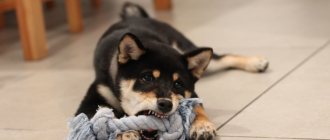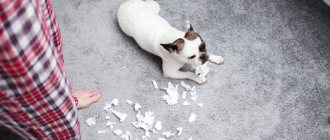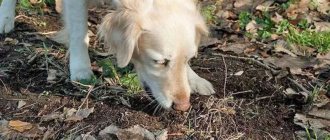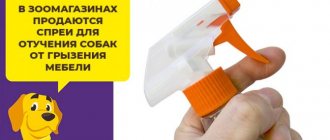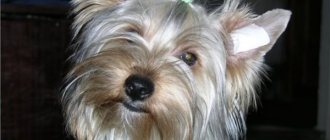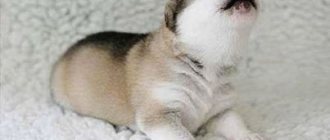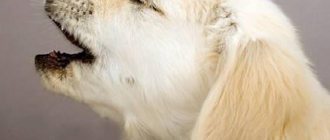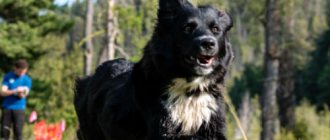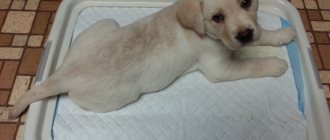When a dog appears in the house, not all novice owners imagine what it is like to raise and maintain a four-legged active friend. Most people adopt puppies, some adopt adult dogs, but not every pet can immediately become an ideal family member.
For example, many dogs, both in puppyhood and adults, for some reason begin to “destroy the house,” namely, chew things, including furniture. Both the renovation and the interior as a whole can be seriously damaged by an angry pet.
But, fortunately, in most cases, destructive behavior can be corrected. How to stop a dog from chewing furniture? First, you should find out why she does this, and also study information about possible methods of correcting unwanted behavior.
How to stop a dog from chewing furniture
Why does a dog chew furniture?
A dog is a living creature with its own character. She can be calm and quiet, almost unnoticeable in the apartment, or she can be a real energizer, who is not heard or seen only if she is sleeping. Also, a dog can have a different psyche - be a stress-resistant animal or, conversely, be acutely worried about the slightest reason. Moreover, the reasons may be those that seem insignificant to people, but for a dog they are a real nightmare. In some cases, it is stressful situations that can force even a well-bred pet to spoil a dear sofa or favorite nightstand.
A dog may chew furniture for a variety of reasons.
It is also worth considering the age of the pet . For example, puppies are much more likely than adult dogs to cause material damage to the home and interior items in it. And the kids are not at all to blame for this. The fact is that at the age of 3-6 months they are not only actively learning about the world around them, but also teething, causing some discomfort. As a result, the puppy tries everything “by tooth”, which is extremely disliked by the owners.
Why does the dog do this?
On a note! For a dog, gnawing is a natural process. It’s just that animals never spoil things. Dogs can chew something while playing, developing, nervous, or communicating.
For a dog, gnawing is a natural process.
There are many reasons why a pet damages furniture. We will try to point out the main ones below.
If the owner is absent for a long time, the dog can do serious things.
Ingar 02/13/2007 - 09:01
There is also an effective method. Usually, owners have toys for dogs lying around in bulk - take what you want and when you want. But for some reason the dogs show no interest in them, to the surprise of the owner. Only when mom and dad pull the other end of the harness does the dog begin to play. Is it the same for you? The way to attract attention to toys is very simple and effective. When I read about it, I was very surprised, and then I took a closer look at my dog, and it turns out that it also works fully for us.
Meaning: 1. You don’t give all the toys at once, but one at a time (3-4 pieces), putting the rest out of sight for a while. After a week or two, you change the assortment: the first portion is for disinfection and hidden, the second portion is laid out. The dog's interest increases sharply, as if he has received new toys. 2. toys should be of all types (can be one at a time) - plastic (a couple of soda bottles, for example), a piece of wood (not splintered. For example, a fresh flexible rod of a non-bitter tree with bark together), a rag-rope (a tourniquet or a fire hose ) 3. AND THE MOST IMPORTANT THING. Toys should not be piled up on the floor, but placed in a box or some kind of niche-stand so that the dog can take them out himself. Here the instinct kicks in, just like in small children - to pull everything out and scatter it around the room! In the meantime, he chooses, pulls out, plays, goes after the next time, it’s getting closer to evening and the owner has come home from work.
This is some simple science. We also have toys in a niche and the dog comes there and looks at her wealth with a thoughtful look, choosing what she wants to play with now. Added to
Owner's oversight
Very often, damage to the owner's property is due only to the fact that the dog was simply not explained in time that it is forbidden to chew furniture. Many people are touched by watching a puppy ruffle a pillow or slippers, and then wonder why he began to chew the legs of a chair or scratch the sofa. When a puppy starts teething, he begins to spoil things even more diligently just because he needs to scratch his gums with something, and he simply doesn’t know what he can and cannot do.
Puppy teething
If you don’t stop unwanted behavior in time and don’t show the dog what you can play with and what you can’t, then in the future it will be extremely difficult to correct the situation with furniture damage. And as the baby grows, the losses will become more serious. The owner's oversight can provoke the development of an undesirable habit of gnawing everything . That is why it is important to understand that a small puppy needs to be given a lot of attention and monitor what he does right and what he does not.
The habit of chewing on everything may be the result of an oversight by the owner
On a note! By gnawing something, a dog gets a kind of pleasure that people cannot understand. This is due to natural instincts - in the wild, canines, when catching prey, tear it apart with their teeth. And by gnawing something, the dog imitates this behavior.
This category of problems also includes an irregular daily routine, when the dog does not get used to walking or playing at a certain time of day. She doesn’t know whether to expect some kind of entertainment with her owner or to keep herself busy on her own.
Dogs need to be trained to walk or play at certain times of the day.
Stress and nerves
Whatever one may say, a dog is a living creature, which is characterized by its own experiences and problems. For example, having become nervous for some reason, a puppy or an adult animal, in order to somehow calm down, may begin to nervously lick its paws, or may begin to chew on the owner’s favorite chair.
Stress can cause your dog to chew furniture
Causes of stress can be:
- loss of owner for a long time;
- a change of scenery;
- travel on public transport or flight;
- changing of the living place;
- visit to the veterinarian;
- undeserved punishment.
When to punish a dog?
On a note! Some dogs are more stress-resistant, some less so. But in any case, if some situation can provoke stress in an animal, it is better to first try to prepare the pet for this. For example, to get used to carrying before making a long journey.
A very big stress, especially for social breeds, is the long absence of the owner in the house. This situation can easily encourage the dog to damage furniture and other things.
Stress can be associated with different events
Boredom and lack of communication
Most dog breeds cannot tolerate prolonged loneliness, as well as boredom and lack of communication with their relatives. Sometimes an animal, sitting at home, simply does not know what to do with itself if it is left to its own devices. And attempts begin to try everything by tooth.
Boredom is another reason why a dog chews furniture.
Also, many dogs begin to damage furniture if they lack physical activity and proper walking. You need to walk with your pet every day for several hours a day, and the walks should be active and eventful, especially for dogs of active breeds (huskies, boxers, Labradors, etc.). If you neglect this, then one fine day you may find a real pogrom at home, like after a hurricane. And it is useless to scold the dog - it was simply trying to realize its energy in some way.
The dog needs to be walked several hours a day
Your pet's activity needs to be given due attention.
Age
Adult animals, with sufficient daily exercise and sufficient communication, rarely spoil things in the house. But puppies (about 90% of all babies) are sometimes quite active destroyers of apartments and property. And the point here is not that the dog is stupid or bad - the animal simply due to its age, like a child, plays in its own way.
On a note! From puppyhood, a dog should be taught to play only with its toys. If this is not done in time, then you may encounter a situation where the pet moves on from playing with slippers to mastering larger things.
Puppies are very active destroyers of furniture and other objects.
It is also important not to forget that puppies change their teeth between 3-4 and 6 months, and this means unpleasant sensations, discomfort and itching. During this period, only dog chew toys will help the puppy. If they are not available, then the owners will most likely be faced with the problem of damaged items.
On a note! The less the puppy is left home alone, the lower the risk that he will spoil something.
For a dog, gnawing is a natural process.
By the way, during these same months the puppy actively gets acquainted with the outside world. And this also affects attempts to chew something. It is important to know that the puppy does not understand what can and cannot be touched . He needs to explain this in simple and understandable dog language. It is also important to understand that many things in the house can pose a danger to the baby’s health. The same stuffing material from a sofa cushion or a chewed chip from a stool can lead to dire consequences and long-term treatment at the veterinarian.
How to make a bar stool with your own hands?
In our new article, we talked about making bar stools, provided detailed step-by-step instructions for the best options, and also showed the most original and beautiful ideas! More details in this article.
Health problems
Some diseases can also provoke the desire to gnaw on everything. So, when they have worms or stomach pain, dogs in the wild will usually eat grass in an attempt to cleanse their stomach. If plants are out of reach for pets, they may try to chew wooden chair legs, wallpaper, floors, and paper. And this is not an attempt to mischief, but only a desire to relieve the discomfort in the stomach.
A dog can chew on everything due to worms
Advice! You can grow grass for your puppy at home or buy it from a pet store. Also, do not forget about preventive deworming, which is carried out quarterly.
Worms in dogs: symptoms of infection
Perhaps the dog lacks some vitamins and begins to chew the furniture around it. It is recommended to regularly drink courses of special fortified preparations, which can be selected at a veterinary pharmacy.
the right amount of activities and walks
Normal Behavioral Responses
Even blind puppies are exploring the whole world by taste, by analogy with children, this process needs to be controlled, but it cannot be interrupted. If your already conscious, grown-up puppy eats sand, then the motivation is predictable:
- The dog explores the world.
- Four-legged animals like the taste of sand (this will pass).
- The pet is affected by worms.
- The pet lacks vitamins or microelements.
- Disorder of the gastrointestinal tract.
In the first two cases, the owner should be patient; after all, eating sand is also a life experience that even many people have gone through. There is no need to worry if the dog swallows sand along with torn grass; as they say, the main thing is that the pet likes it.
Additionally, most dogs that chew herbs will vomit, which is a natural process. An uncontrollable desire not only to chew, but also to swallow sand is the true cause for concern.
Some dogs love to eat enriched flower soil to the point of shaking their paws. Many varieties of such soil are associated with sand, which is also very successfully eaten. This behavior is typical for dogs living in an apartment, especially in winter. Having noticed attacks on domestic flowers, it is worth taking a number of measures:
Conduct a vitamin course, since most dogs eat flower soil to obtain microelements.
Move the pots out of reach of the pet, as a young dog can get carried away and fanatically eat the sand that is sprinkled on the flowers.
Start raising a dog, since eating house flowers is a bad habit that is quite difficult to fight.
The reason for eating sand may be hidden in passion, for example, when a dog chews a stick while lying on a sandy surface. An owner who hears the sound of sand rubbing against a pet’s teeth is literally horrified, but the dog doesn’t notice anything.
On the one hand, when chewing a stick (even if it is in the sand), the pet acts without extraneous intent - it simply brushes its teeth. On the other hand, frequent scratching of enamel with sand can lead to quite tangible problems - tooth decay. If your pet is very fond of crushing sticks, it is worth purchasing special toys and treats that allow the dog to clean off plaque.
How to stop chewing furniture?
The easiest way is to stop a small puppy from chewing furniture while negative habits have not yet taken hold. It is much more difficult to accustom an adult pet with a formed character to order. But, nevertheless, nothing is impossible; any dog can be dealt with and negotiated if there is a desire. Depending on a number of factors, you can use several methods to wean your pet from damaging furniture. Let's look at the main ones.
It’s easier to stop a puppy from chewing furniture
Boch 02/13/2007 - 03:40
It would be nice to figure out the reason for this behavior. 1) The dog has nothing to do while the owners are away. And the dog has fun as best he can. 2) Or maybe everything is much more complicated. The dog has a phobia (cannot be in a confined space alone) 3) Another option. If you think with the brain of a dog. “The more I chew, the faster the owner will appear and pay attention to me.” He'll pet me and play with me.
I like the option with chloramphenicol. Give it a try. Antigryzin does not always help.
You can also buy a spacious crate and leave the dog in it while you are away. (and this is not cruel treatment. On the contrary, the dog will have its own home. Our friends have a dog that opens the cage door itself and goes in there.)
How to stop a puppy from chewing things
Let's start with the simplest thing - raising a puppy. Of course, in fact, this is a serious and responsible process, but still, teaching a child to control his emotions and desires in relation to attempts to damage furniture is much easier than an adult dog.
First of all, you need to understand that the child is not doing this out of malice, and you cannot punish him by coming home from work and discovering that everything in the house is upside down. Punishment must occur immediately at the time of the commission of the offense . Everything that happened after the offense was committed will not work, but will only cause the baby to fear the owner.
The dog should be punished only at the moment of committing the act.
Attention! You cannot hit a dog with your hands! It is best to approach him at the moment of committing an offense and take him by the scruff of the neck, lifting him into the air. You can even shake it lightly - this is how their older brothers punish guilty puppies. You can also simply click the baby on the nose.
It is advisable to constantly monitor the puppy while he is small, like a small child, and promptly stop unwanted actions, as well as protect him from troubles. It is worth playing and engaging with him regularly/in an interesting way - then the dog will wait for these very moments of playing with a person, and the rest of the time he will just sleep.
Another important rule is a large number of different toys. It is not enough to buy one ball and think that it will be enough. Toys should be constantly updated and changed so that the baby is interested in fiddling with them and exploring them.
The puppy needs to be provided with a lot of toys
You should also teach your dog to only play with his toys. For example, at the moment when the puppy aims his teeth at his favorite sofa, it is worth distracting him with a toy and playing with him. And do this every time the baby tries to show excessive interest in interior items. Over time, he will understand that he can only play with his own things. It is also worth understanding that a puppy may be bored playing alone with even the most interesting toys, and he will quickly get bored with them. So the owner’s personal time will also have to be spent on activities with the baby.
A dog should only play with its own toys
Important! You should not allow your dog to play with old slippers or pillows, as well as other things that a person no longer uses. The fact is that the dog does not understand whether the thing is old or new; for it, any pillow can become interesting if you allow it to play even with the old one. So you need to switch the puppy’s attention to his personal toys as soon as he becomes interested in something that a person uses.
Playing with other dogs is also very important
The dog will appreciate such gifts
The solution is a cage?
If a person is forced to leave the puppy at home alone for a long time, although this is not welcome, then you can try to limit the space in which the dog can move while it is home alone. Alternatively, these could be special indoor enclosures or cages for dogs. While in it, the puppy simply will not be able to get to the furniture and ruin something.
Your pet's activity needs to be given due attention.
Important! You can’t keep your puppy locked up for a long time, and you should also choose an enclosure or cage that gives the dog some space. There should be no cramped cells.
Double door dog cage
Before you lock your puppy up and leave to run errands, you need to do a lot of crate training. If you simply push the baby into it and close it, then the cage will no longer cause anything but fear in him. It may well be that he will whine and howl all the time while in it. To prevent this from happening, you need to accustom your dog to a crate.
Step 1. First of all, you need to buy a cage. For a puppy, it should be purchased in such a size that an adult dog can fit in it, and can easily turn around, lie down and stretch out to its full height. The cage should have a tray that will cover the bars on the underside of the cage.
The cage must be of suitable size
Step 2. Next, the cage needs to be assembled and installed at home in some place where it will not disturb anyone.
It is important to choose the right place to install the cage
Step 3. During the first days, the cage should be left with the door open so that the dog can enter it and sniff it. Under no circumstances should you frighten the puppy when he gets acquainted with the crate.
The puppy must get used to the crate
Step 4. After the crate has been open for several days and the puppy has gotten used to it, you can begin to accustom him to it. For example, you can throw your puppy's favorite toy or treat into the crate, or you can feed him directly in the crate.
You need to gradually accustom your puppy to a crate.
Step 5. You can play with the puppy right in the crate - then he will not pay much attention to it.
You can play with the puppy right in the crate
Step 6. When the dog begins to calmly perceive the crate as part of the house, you can try closing the door. The first times you need to do this literally for a few seconds so that the baby does not start to worry. As soon as the door opens, and especially if the puppy behaved well and did not cry, he must be petted and praised.
The dog should perceive the crate as part of the home
Step 7. Gradually, the time spent in a closed cage can be increased. Some puppies quickly get used to being in a locked crate and do not howl; others will take more time to get used to it. But it's worth it. If the puppy begins to howl, it is better to wait until he calms down a little, and only then open the cage and praise him.
The time spent in a closed cage can be increased
Video - How to crate train a puppy
How to survive the teething period?
In some cases, during the period when the puppy is cutting its molars, it is quite possible to do without a crate if you follow simple instructions.
Step 1. First of all, as mentioned above, you need to buy toys for puppies. They must be of high quality and such that the baby cannot bite off a piece of them. They should also be the right size for the dog - you shouldn't buy balls for a small dog that a Great Dane plays with.
Get some puppy toys
Step 2. To attract attention to the toy, you can smear something tasty on it. It may well be that fragrant smells will make the puppy show a healthy interest in the new object.
Lubricate the toy with something tasty
Step 3. During the period when teeth are being cut, you can use a special gum scratcher. This will reduce the puppy's desire to chew on something.
Use a special gum scratcher
Step 4. You can buy chewy treats for puppies, gnawing which, the dog will be able to bite off pieces and even swallow them, but without harm to its own health.
Buy chewy treats
Step 5. The puppy should be prohibited from playing with objects that are not intended for play - shoes, furniture, etc.
Prohibit your puppy from playing with all objects that are not allowed to be played with.
Behavior correction methods
Next, we will look at techniques on how to stop a puppy from picking up everything on the street. They also work with adult dogs, but require more patience from the owner. Absolutely all of the methods below have disadvantages. Your task is to choose the “lesser evil”, focusing on the dog’s temperament.
Fake Situation with Physical Punishment
The first thing to do is to accustom the dog to wearing a parfors (strict collar). The training will take some time. You can start when your pet clearly understands that incorrect behavior is followed by punishment - pain. Next, you need to choose an area where there are no strangers or animals and ask a friend to scatter bait (food). Do not toss the food yourself, as your scent will remain on the pieces! We head to the place of the setup, walk within a radius of 2–3 meters, gradually approaching the intended goal. As soon as the dog picks up a piece - a sharp jerk and the command “Fu!”, you must remain calm and unperturbed. We repeat the fake situation 3-4 times or until the pet gives up the bad habit.
Cons: not suitable for short-haired dogs; causes pain to the pet; takes a lot of time; assistant needed.
A fake situation with “peppercorn”
We stuff the pieces of meat with mustard, ground black pepper or other hot seasoning. We prepare a dummy place, let the dog learn from its own mistakes. Do not use red pepper or any hotter “drugs” under any circumstances.
Cons: you take a risk, since your pet may have an individual intolerance to seasonings; the dog may smell the filling and not take the “bait”; By using “dangerous” spices, you can deprive your dog of his sense of smell or “reward” him with burns to his mouth.
Sound stimulus
You will need a cylinder with compressed air and a “dudelka”, they are used by fans at stadiums. Before using it on the street, practice the reaction at home, show the dog what will happen if it commits a prohibited action. Next, we do the same on the street, when trying to pick up food from the ground
It is important not to use the balloon too close to your pet.
Cons: causes inconvenience to people around; not suitable for dogs that are afraid of loud noises; If used incorrectly, the cylinder can lead to hearing impairment.
Electric shock collar (ESC)
Before the invention of the ESH, it was believed that the only way to ensure that a dog could stop picking up food on the street was with the help of a piece of meat and an electric magneto. The device was placed in a shelter, clamps were attached to the bait, the handle was untwisted (or a friend was asked to watch in the shelter) and the dog was allowed to grab the meat. The tailed one was hit with a strong electric shock and the job was done. The difficulty and general inconvenience of this technique is simply off the scale, starting with the fact that you need to take a magneto somewhere, ending with the fact that the dog can understand the essence of the owner’s insidious idea.
Using an EShO simplifies the task several times:
You do not punish the dog yourself, which means you do not spoil the relationship.
The collar is controlled by a remote control, which means you don’t need to run after the tailed one, you just need to keep an eye on it.
Typically, the device has two modes: vibration warning and shock, which makes your conscience and your dog’s life easier. When the pet tries to break the rules again, he no longer needs to be shocked, just press the vibration-shock button and the sly one will immediately understand what is going on.
Usually, 2-3 incidents (1-2 months, to be completely sure) are enough to correct behavior with the help of EShO, so you don’t have to buy the accessory, but rent or borrow it.
How to stop an adult dog from damaging furniture?
The situation with an adult dog chewing furniture is complicated by the fact that the animal has already grown up and has developed certain habits that are not always pleasant for the owner. In this situation, it is important to consider a number of certain factors. But by following simple instructions, you can also solve the gnawing problem.
Step 1. It is important to walk your dog a lot, especially an active breed, and also give it the opportunity to communicate with its relatives. Coming from a walk tired and happy, the dog will most likely just go to bed and will have no time to damage the furniture.
An adult dog should play with other dogs
Step 2. In some cases, if you need to leave the house, you can turn on the radio or TV for your dog. This will create a certain effect of a person’s presence in the house, and the pet will be calmer and not so bored.
You can turn on the TV for your pet
Step 3. You need to play with the dog, and leave toys for him when you go somewhere. Moreover, just like with a puppy, it is important to maintain a variety of toys and choose safe and durable ones. The toy should be interesting for the dog. By the way, now there are even educational toys for dogs on sale that can keep your pet occupied for a long time.
Let your dog play with toys that interest him
Step 4. You must remember to give your dog as much time as possible and exercise with him, play games and develop his mental abilities. A dog tired from the workload will sleep instead of getting bored and damaging the furniture.
Give your dog as much time as possible
Step 5. You should develop a certain daily routine - feed and walk your pet at the same time. Then it will be easier for the dog to control itself in a number of situations and wait for the owner from work.
Develop a specific daily routine
Step 6. In some cases, you will not be able to cope with the situation on your own - then you should contact a dog trainer or dog psychologist, they will help solve the problem.
If necessary, consult a specialist
Video - How to stop a dog from chewing things
Regular physical training
Knowing which dogs chew furniture and why they do it, as well as the natural energy of these pets, you should provide them with an opportunity to burn off their energy every day. To do this you need to walk with them. Daily physical training is the basis for the proper physical and psychological development of a pet, and if it lacks physical activity, it begins to direct its enormous energy to the destruction of household furniture.
You can physically stress your dog in various ways:
- long walks with your pet;
- active games with the dog in the fresh air;
- dog playing with other pets.
If the owner does not have the constant opportunity to spend sufficient time with his pet, then veterinarians recommend occupying his attention with various toys that will develop not only the physical qualities of the pet, but also his mental abilities.
“Anti-gryzin” type products
Chemistry has firmly entered the life of modern man and is actively used in keeping dogs. Now certain chemical compounds have been developed that are absolutely safe for dogs and humans, but can help accustom a pet to a sleeping place, a toilet, or discourage it from encroaching on furniture . The latter are popularly called anti-rodents, but in fact this is only one of the names of a certain remedy. Let's look at the most popular substances that are used to wean a dog from trying to chew something.
There are special means that can prevent such situations
Table. Anti-rodents for dogs.
| Name | Description |
| 8IN1 NM NO-CHEW | This remedy is considered one of the best for correcting dog behavior. It will help wean the animal from chewing everything in the house, not just furniture. Safe, does not irritate the skin and mucous membranes, does not leave stains on furniture. The drug also contains sedatives that will relieve the animal’s anxiety. For dogs, the product tastes bitter, which discourages them from chewing on the sprayed object. |
| TropiClean Stay Away | This substance contains very bitter components, but safe for pets. They help cope with constant gnawing in the house and licking of certain places. You can even spray plants with it, protecting them from being eaten. |
| Mr.Bruno Spray No problems | The spray should be used regularly, spraying furniture approximately once every 3-4 days. Dogs don’t like its taste and smell, and they gradually wean themselves from trying what they don’t need on their teeth. |
| Antigryzin Himola | The most famous spray against damage to furniture and other objects by teeth. Contains substances that smell unpleasant to dogs. Suitable for use during teething in puppies. |
Attention! Anti-rodents often do not live up to expectations, so you shouldn’t place much hope on them.
If a prankster is caught at the scene of a “crime”
If a dog is chewing furniture, and you catch it at the scene of the “crime” at the very moment when it is chewing not a toy, but furniture, then it is at this moment, and not later, that it should be scolded.
Sternly say: “Ugh!” and pat your pet by the scruff of the neck, imitating the behavior of a mother dog. This is how she lets the naughty pet know that he did something wrong.
As soon as the puppy stops the unwanted action, praise him and distract him with a toy. I repeat once again that you need to punish an animal exactly at the moment when you catch it at the scene of the “crime”.
If you returned home from work and the sofa has already been chewed, then in this case you need to understand and forgive the four-legged one! It is no longer possible to scold and punish him. Otherwise, the tail will associate the punishment not with the chewed thing, but with the appearance of the owner.
As a result of this, the animal will only be afraid of the owner. And the task of every four-legged owner is to make sure that your pet is not afraid, but trusts you and sees you not as a threat, but as the leader of the pack, who can protect and caress him at any moment.
Thus, if a dog chews furniture, then only the owner of the four-legged dog must determine the reason for this behavior and take the necessary measures. From the very beginning, you must show the puppy what is good and what is bad.
Think in advance whether you can devote enough time and attention to your furry so that he does not feel lonely and abandoned. And if you are planning to adopt a Jack Russell Terrier puppy, then this is especially important, because these restless dogs require a lot of attention and communication. Read about the character of the Jack Russell Terrier. If you are in doubt, think a hundred times whether you should get a dog at all.
